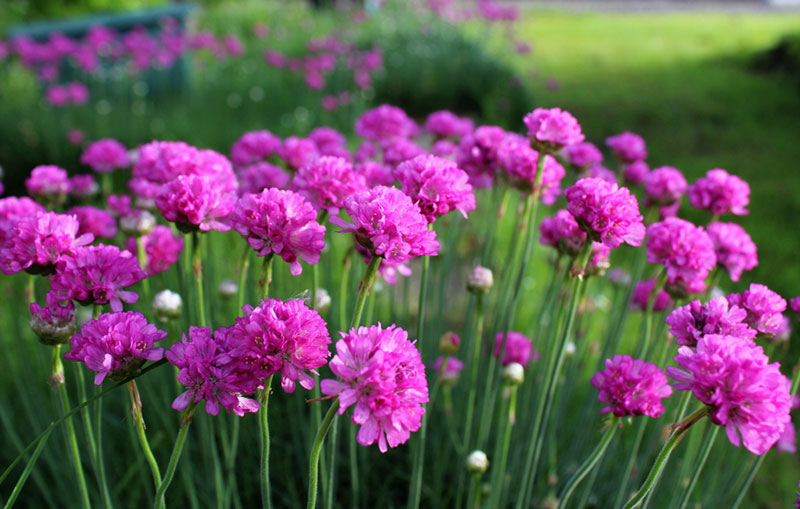
Sea Thrift (Armeria ‘maritima’) is an herbaceous, evergreen perennial plant hardy in USDA plant hardiness zones 4 through 8. It produces globe-shaped clusters of flowers that range from white, pink, red and lavender, blooming in late spring or early summer.
Some varieties continue to bloom periodically throughout the summer. Foliage is mounding with grass like leaves. Plants reach a height of 6 to 12 inches with an equal spread, making them a popular choice for rock gardens.
Light and Temperature Requirements
Sea thrift prefers full sun for 6 to 8 hours a day, but the hours of sunlight do not need to be consecutive. It will thrive with several hours of direct sunlight, some shade during the noontime or afternoon sun and another few hours of sunlight again later in the day. Most flowers prefer strong morning light and sea thrift is no exception.
It is especially sensitive to cool, wet seasons and may die out if the fall is cool.

Watering
Sea thrift is drought tolerant and does not tolerate moist soils well. It will die out in areas where the soil remains moist for long periods.
Newly planted sea thrift requires moderately moist soil until they are established but use care that the soil does not get soggy.
Soil and Fertilizing
Sea thrift does not like rich soil but does require soil that is well-drained. Sandy soil is ideal. Soil that is too rich will cause the foliage to flop outward and the center of the plant to die. Likewise, soil high in clay content will cause the plant to suffer.
When planting sea thrift use care not to add too much organic matter and do not fertilize it. An addition of peat moss may be necessary in sandy or gravelly soil to improve drainage. Because sea thrift tolerates a wide range of soil pH from alkaline to acidic, the possible consequences of lowering the pH with peat moss is not a concern.
Deadheading and Pruning
Sea thrift should be deadheaded to remove spent flowers. This keeps the plants looking good while forcing the plant to produce new flowers. The plants can be sheered back after blooming to force a new flush of blooms later in the season.

Propagation
Sea thrift can be propagated via cuttings in summer or by lifting and dividing the roots in the spring or fall.
How to Take Cuttings
- Cut a 4-to-6-inch stem tip just below a leaf joint.
- Remove the leaves on the bottom 2 inches of the cutting and pinch out the growing tip.
- Dip the cutting in rooting powder and shake it gently to remove excess powder.
- Insert the end of the cutting into a pot of moist perlite or vermiculite. You can also use a soilless seed starting mix.
- Cover the cutting with a plastic bag to retain moisture.
- Place the cutting in a location that receives bright, indirect light.
- Repot the cutting to a larger pot once new growth appears and the roots are established. To test for root formation, tug gently on the cutting. If it resists your efforts roots have formed.
Lifting and Dividing Sea Thrift
- Dig around the base of your sea thrift plant with a garden shovel or spade.
- Slide the blade of the shovel under the root ball and lift it free of the soil.
- Shake the root ball to remove excess soil. You can also use the garden hose to remove the soil so you can get a better look at the roots.
- Pull the plant into two or more sections leaving at least 3 shoots in each clump.
- Trim off any dead or discolored roots.
- Replant your sea thrift plants in similar growing conditions as the original plants.
Starting Sea Thrift from Seed
Sea thrift can take up to a month to germinate, making it a difficult plant to start inside. However, sea thrift seeds can be scattered outside in the garden for late summer or early fall blooms. Prepare an area for your sea thrift plants in late spring and scatter the seeds over the top of the soil. You can rake them lightly, but do not cover the seeds as they need light to germinate. Keep the area moist until seeds germinate in 20 to 30 days. New seedlings may not bloom the first season, but will return and bloom the following year.
Sea thrift is an attractive flower that is often grown in rock gardens, but it can also be grown in the fronts of flowerbeds or along walkways to add a splash of color the yard. Some dwarf varieties like ‘Vindictive’ can be grown as ground covers. In the wild, sea thrift grows in coastal areas and is tolerant of salty soils.



